Inventory optimization drives efficiency
Empower your business to make informed decisions across various facets of inventory management, from inventory levels to supply chain optimization, with Phocas.

Inventory planning is all about the data
Phocas provides an inventory optimization software solution by pulling ERP data and other sources into one centralized platform. Making it easy for everyone to tap into sales, purchase order and inventory-level data. Helping to optimize inventory planning and improve demand forecasting.
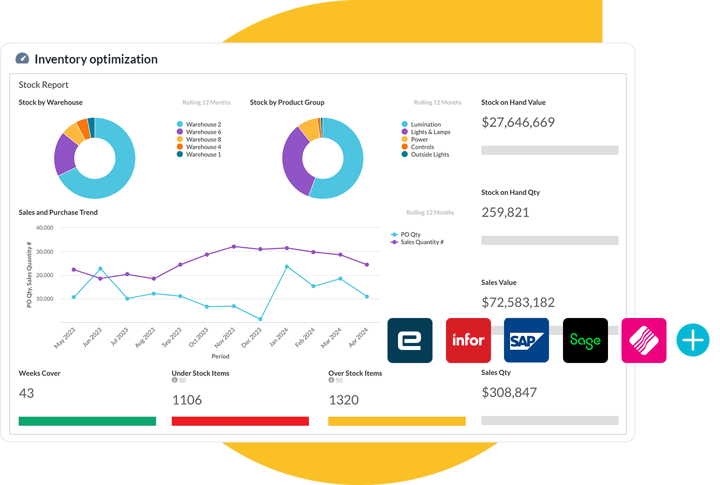
Meet supply and demand
- Ensure optimal inventory levels with a clear view of what’s moving and what isn’t
- Forecast demand and see which products need replenishment, liquidating or moved between locations
- Track seasonality trends
- Use purchase history and sales forecasts to predict stock levels needed months in advance
- With accessible, up-to-date data, purchasing and inventory teams can control pricing, improve supply chain planning and maximize profitability.
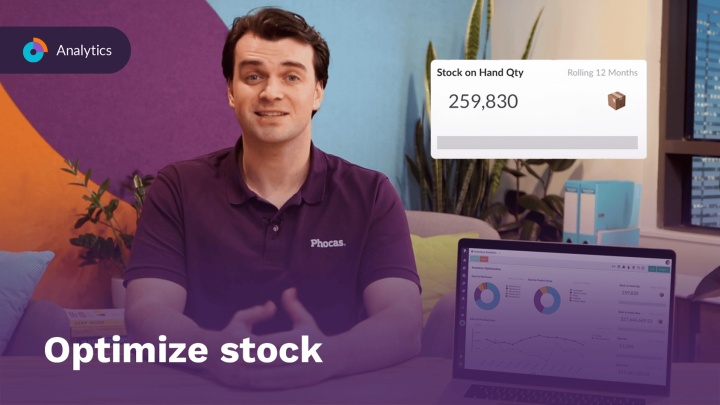
Customer quote
“We import a range of products from overseas where we need to order them months in advance. By looking at the sales history we can predict what stock levels we are going to need in the coming weeks and months. For stock management, Phocas is absolutely brilliant.”
— Chris Rath, Operations Manager at Tradeware.
Sage + Phocas customer
Forecast demand by segment
- Analyze patterns and forecast demand for different market segments; customer demand by product class, geography, sales channel, behavioral segments (purchase history), seasonality etc
- Adjust demand forecasts based on live sales data and changing trends
- Compare forecasted demand with actual demand data over time.

Smart purchasing and holding
- Review order quantities against purchased stock levels
- See which departments, categories or product lines are the most profitable inventory investments
- Ensure products are in the right locations and distribution centers based on customer demand
- Quickly see what you're holding and selling by location, quantity, value.
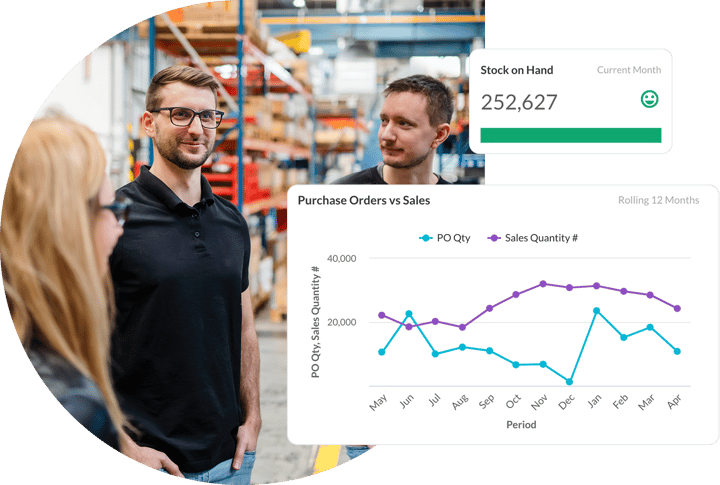
Clear inventory visibility
Phocas has helped Savona better plan for seasonality and establish different stock holding policies for different products depending on whether they’re identified as slow or fast moving.

Fast, accurate reporting for everyone
- Fast, easy access to all your data within a centralized platform makes it simple to pull reports instantly
- Human-friendly software empowers everyone to create their own reports or customize existing templates
- Independently view, understand and share up-to-date results with the wider business - sales, finance, operations.
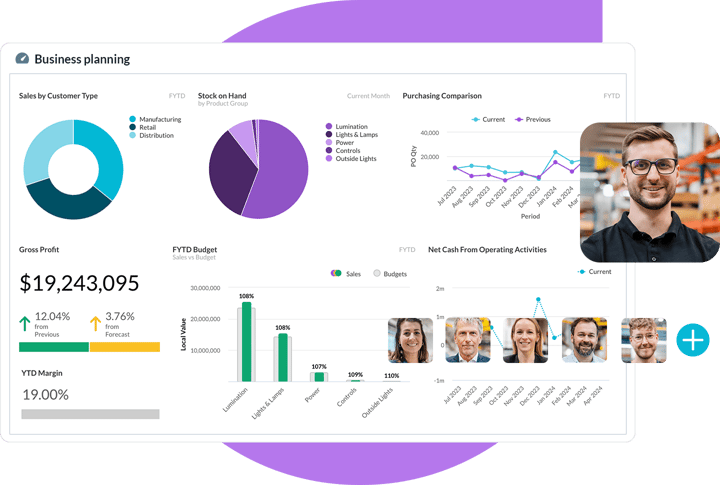
Customer quote
“Our data in Phocas, combined with our retail partners' sales data lets us plan inventory to place the right commitments with our resources and vendors overseas. This allows us to make sure we're holding the right number of weeks stock domestically to meet demand. It ensures that we are running a profitable business.”
— Harvey Lewis, General Manager at Caprice.
Improve customer service levels
- Proactively improve supply chain management with up-to-date visibility into supplier performance, lead times, and order fulfilment processes
- Regularly reviewing supply chain performance on a cloud-based platform allows you to optimize procurement processes and mitigate risks associated with supply chain disruptions.

Simplify inventory management with one platform
View data any way you like
- Unlimited custom dashboards provide high-level overviews, enhancing multi-echelon (locations) inventory optimization
- Drill into underlaying dashboard data to identify areas such as excess inventory on slow-moving unprofitable stock
- Add customized calculations that make sense for your inventory planning such average inventory COGs over 12 months.
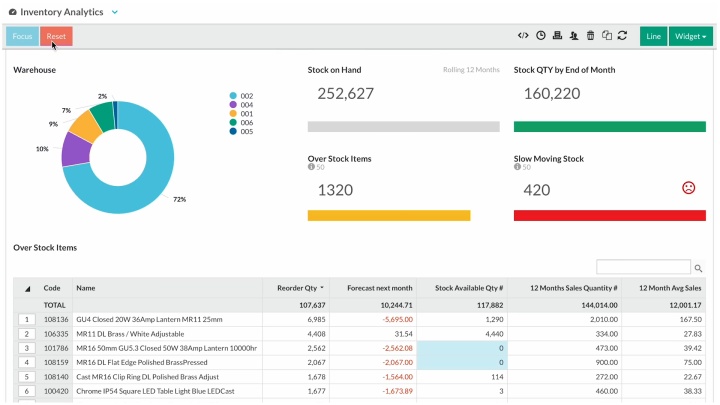
Featured Guide
Data-driven inventory optimization eBook
Discover how data analytics can improve inventory management
Download nowFrequently asked questions
Inventory optimization is the process of strategically managing and controlling a company’s inventory levels to maximize efficiency and profitability while also minimizing costs and risks.
The benefits of using inventory optimization software is that it allows you to balance the trade-off between having enough inventory to meet customer demand without holding excess stock that ties up capital and incurs inventory costs.
Overstocking ties up capital and warehouse space, increases carrying costs, and can lead to products going out of date or becoming obsolete. On the other hand, understocking can result in stockouts, lost sales, dissatisfied customers, and potentially damage to the company's reputation.
By leveraging techniques such as demand forecasting, inventory segmentation, safety stock optimization, and inventory replenishment strategies (like just-in-time inventory), businesses can ensure they have the right inventory levels on hand at the right time and in the right location and distribution centers. This helps to improve customer service levels, reduce carrying costs, minimize stockouts, and ultimately enhance overall operational efficiency and profitability.
The benefits of using inventory optimization software is that it allows you to balance the trade-off between having enough inventory to meet customer demand without holding excess stock that ties up capital and incurs inventory costs.
Overstocking ties up capital and warehouse space, increases carrying costs, and can lead to products going out of date or becoming obsolete. On the other hand, understocking can result in stockouts, lost sales, dissatisfied customers, and potentially damage to the company's reputation.
By leveraging techniques such as demand forecasting, inventory segmentation, safety stock optimization, and inventory replenishment strategies (like just-in-time inventory), businesses can ensure they have the right inventory levels on hand at the right time and in the right location and distribution centers. This helps to improve customer service levels, reduce carrying costs, minimize stockouts, and ultimately enhance overall operational efficiency and profitability.
- Demand forecasting capabilities: The software should have robust demand forecasting features to accurately predict future demand based on historical data, seasonality, trends, and external factors.
- Inventory segmentation: Look for software that allows you to segment your inventory based on various criteria such as demand patterns, profitability, lead times, and SKU velocity. This enables you to apply different optimization strategies to different segments of your inventory.
- Safety stock Optimization: Ensure the software offers capabilities to calculate and optimize safety stock levels based on demand variability, lead times, and service level targets.
- Supply chain Integration: Choose software that integrates seamlessly with other supply chain management systems such as ERP, warehouse management, and procurement systems. This facilitates real-time data exchange and ensures consistency across the supply chain.
- Multi-echelon inventory optimization: If your business operates in a multi-echelon supply chain (e.g., multiple warehouses or distribution centers), look for software that can optimize inventory levels across all echelons while considering interdependencies and constraints.
- Scenario analysis: The software should allow you to conduct "what-if" scenarios and simulations to assess the impact of different inventory policies, demand scenarios, lead time variations, and other factors on inventory performance.
- User-friendly interface: The interface should be designed to be intuitive and easy for everyone in your business to learn. This will significantly increase user adoption. Look for software with a clean layout, customizable dashboards, and interactive visualizations.
- Reporting and analytics: Ensure the software provides comprehensive reporting and analytics capabilities to track key performance metrics, monitor inventory performance, and identify areas for improvement. Reporting should also be easy for everyone to perform themselves without having to rely on IT or finance.
- Scalability and flexibility: Choose a solution that can scale with your business growth and adapt to changing requirements. It should support customization and configuration to accommodate unique business processes and workflows.
- Customer support and updates: Consider the reputation and track record of the software vendor, including their customer service levels, frequency of updates and enhancements, and commitment to ongoing product development.
Understand the past, operate better today, and plan well for the future
Whether you want to get your data organized for your team or you’re looking to combine business intelligence capabilities with financial reporting, planning and forecasting… We can help.
Get a demo






